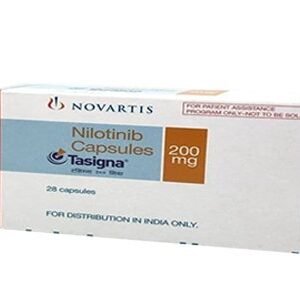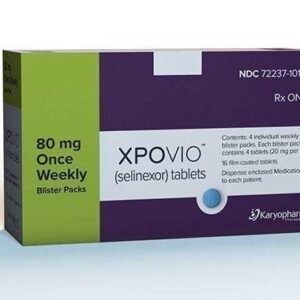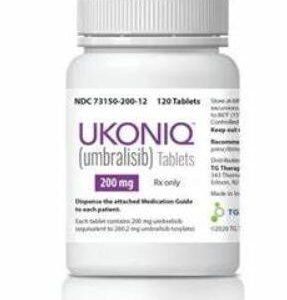Ifosfamide for Injection
Effects and efficacy:
Applicable to testicular cancer, ovarian cancer, breast cancer, sarcoma, malignant lymphoma and lung cancer, etc.
Usage and dosage:
This product is administered by intravenous drip. This product is dissolved in sterile water for injection and then further diluted with 500-1000ml of 0.9% sodium chloride injection and then slowly dripped intravenously for at least 30 minutes. Monotherapy: intravenous injection of 1.2-2.5g/m2 per body surface area, 5 consecutive days as a course of treatment. Combination therapy: intravenous injection of 1.2-2.0g/m2 per body surface area, 5 consecutive days as a course of treatment. The next course of treatment should be 3-4 weeks apart or after blood toxicity is recovered (platelets 100000/μl, white blood cells 4000/μl). The maximum dose is 18g/m2. To prevent bladder toxicity, a large amount of water should be consumed, and 2L of fluid should be infused orally or intravenously every day. At the same time, protective agents such as mesna should be used to prevent hemorrhagic cystitis. Mesna dissolved in saline is administered intravenously at the same time and 4 and 8 hours after administration. The usual dosage of mesna is 20% of the total daily amount of ifosfamide. The same drug produced by different manufacturers may have inconsistent instructions. If the instructions are inconsistent before taking the drug, please consult a doctor or pharmacist in time.
Drug contraindications:
Allergic to this product is prohibited during pregnancy and lactation. Use with caution in patients with liver and kidney dysfunction
Related dosage forms:
Injection
Read more
Add to Compare
Imbruvica,伊布替尼(亿珂)
Ibrutinib (Imbruvica, trade name: Yike) is the world's first BTK inhibitor approved for marketing. In November 2013, ibrutinib capsules (70 mg and 140 mg) were approved by the FDA for the treatment of mantle cell lymphoma.
Read more
Add to Compare
Nilotinib Capsules
Nilotinib capsules are a tyrosine kinase inhibitor, which is mainly used clinically for adult patients with Philadelphia chromosome-positive chronic myeloid leukemia (Ph+ CML) in the chronic or accelerated phase who are resistant or intolerant to previous treatments (including imatinib).
The main ingredient of Nilotinib capsules is nilotinib, which can inhibit BCR-ABL tyrosine kinase in CML cells, preventing their further growth, spread and division.
Read more
Add to Compare
Oxaliplatin injection
Effects and efficacy: This product is mainly used for the first and second-line treatment of advanced colorectal cancer and postoperative adjuvant chemotherapy for early patients; it is effective for ovarian cancer, breast cancer, gastric cancer, pancreatic cancer, non-small cell lung cancer, melanoma, testicular tumors and lymphoma.
Usage and dosage: Single drug application: The recommended dose is 130mg/m, added to 250-500ml 5% glucose solution, intravenous drip for 2-6 hours, repeated once every 3 weeks. The dose of this product should not exceed 200mg/m to avoid neurotoxicity. There is no need to adjust the dose for patients with mild or moderate renal insufficiency or mild hepatic insufficiency, but it should be used with caution for patients with severe hepatic and renal insufficiency. Combined with fluorouracil: The dose of the next administration should be adjusted according to the degree of bone marrow suppression. If 4-degree diarrhea, 3-4-degree granulocytopenia and (or) 3-4-degree thrombocytopenia occur, the dose of this product should be reduced by 25%, and the dose of fluorouracil should also be reduced. Combined chemotherapy: mainly combined with calcium folinate (CF), fluorouracil, and in recent years also with gemcitabine. The dosage of this product is the same as above. The same infusion bottle cannot be used for fluorouracil infusion, and it is best to be 1 hour apart. The adjustment of dosage should be based on safety, especially neurological safety. Instructions for use Oxaliplatin must be prepared and further diluted before use. The freeze-dried powder preparation must be dissolved and diluted with the specified solution. Instructions for use As with other cytotoxic drugs, the use and preparation of oxaliplatin must be carried out carefully and cautiously in accordance with the precautions. Instructions for operation When handling this cytotoxic drug, medical staff and nurses should be cautious in every step to ensure the safety of themselves and the surrounding environment. The preparation of cytotoxic drug injection solutions must be carried out by professionals who have been professionally trained and have medical knowledge to ensure the safety of the environment, especially the safety of the preparer himself. To achieve this goal, a dedicated area is required. Smoking, eating and drinking are prohibited in this area. The preparer must be well equipped. Long-sleeved work clothes, protective masks, hats, protective glasses, disposable sterile gloves, protective covers on the workbench, and special containers for waste. The patient's excrement and vomitus must be properly handled. Pregnant women should avoid contact with cytotoxic drugs. Any broken containers must be handled with the same care as contaminated materials. Contaminated waste should be incinerated in labeled hard containers. If oxaliplatin powder, reconstituted material or solution contacts the skin or mucous membrane, it should be immediately rinsed with plenty of water. Special precautions for use Do not use injection materials containing aluminum. Do not use without dilution. Do not prepare or dilute this product with saline solution. Do not mix with any other drugs or use them simultaneously through the same infusion channel (especially 5-fluorouracil, alkaline solution, tromethamine and folinic acid drugs containing excipient tromethamine). After infusing oxaliplatin, the infusion tube needs to be flushed. Only recommended solvents can be used. If there is any precipitate in the prepared solution, it cannot be used again and should be destroyed in accordance with the handling principles of hazardous materials required by regulations. Preparation of solution When preparing the solution, water for injection or 5% glucose solution should be used. 10 ml of solvent should be added to the 50 mg package to make the oxaliplatin concentration reach 5.0 mg/ml. From the perspective of microbiology and chemistry, the prepared solution must be diluted immediately with 5% glucose solution. Before use, its transparency should be checked, and only clear solutions without precipitation can be used. This product is for single use, and any remaining solution should be discarded. Dilution before injection Take out the prepared solution from the bottle and immediately dilute it with 250~500 ml of 5% glucose solution to a solution with a concentration of more than 0.2 mg/ml, and then infuse it intravenously. Under normal circumstances, the physicochemical stability of the solution can be maintained for 24 hours between 2℃ and 8℃. From a microbiological point of view, this solution should be used immediately. If it is not used immediately, the user must ensure the storage time and conditions before use. Under normal circumstances, it should not exceed 24 hours between 2℃ and 8℃, unless the dilution is carried out under controlled and confirmed sterile conditions. Before use, its transparency should be checked, and only clear solutions without precipitation can be used. This product is for single use only and any remaining solution should be discarded. Do not prepare or dilute this product with saline solution. Oxaliplatin does not require prehydration for infusion. Oxaliplatin is diluted with 250-500 ml of 5% glucose solution to a concentration of 0.2 mg/ml or above and must be infused through a peripheral or central vein for 2-6 hours. When oxaliplatin and 5-fluorouracil are used together, oxaliplatin should be used before 5-fluorouracil. Waste disposal Any remaining drugs, as well as all items used for preparation, dilution and injection, must be destroyed in accordance with standard hospital procedures for cytotoxic drugs and current legal provisions for the disposal of toxic waste. The same drugs produced by different manufacturers may have inconsistent instructions. If you find inconsistencies in the instructions before taking the drug, please consult your doctor or pharmacist in time.
Drug contraindications:
Allergy to this product is prohibited. Renal impairment is prohibited. Lactation is prohibited. Use with caution in liver and kidney dysfunction. Use with caution during pregnancy
Related dosage forms:
Injection
Read more
Add to Compare
Ozanimod Hydrochloride Capsules
This product is used to treat relapsing forms of multiple sclerosis in adults, including clinically isolated syndrome, relapsing-remitting multiple sclerosis and active secondary progressive multiple sclerosis.
Read more
Add to Compare
Paclitaxel Liposome for Injection
Paclitaxel liposome for injection is a cytotoxic anti-tumor drug with the following indications:
This product is mainly used in the clinic for first-line chemotherapy of ovarian cancer and the treatment of ovarian metastatic cancer in the future. As first-line chemotherapy, this product can also be used in combination with cisplatin.
It can also be used for follow-up treatment of breast cancer patients who have used standard chemotherapy containing doxorubicin or for the treatment of recurrent patients.
It can be used in combination with cisplatin for first-line chemotherapy of patients with non-small cell lung cancer who cannot undergo surgery or radiotherapy.
The main component of paclitaxel liposome for injection is paclitaxel, which can promote the assembly of microtubule dimers and prevent their disassembly. It can also lead to abnormal arrangement of microtubules throughout the cell cycle and the production of microtubule astrocytes during cell division, thereby hindering cell division and inhibiting tumor growth.
Read more
Add to Compare
Secukinumab Injection
Secukinumab injection is a monoclonal antibody drug used to treat a variety of tumors and inflammatory diseases. Its main ingredient is secukinumab, which is mainly used to treat adult patients with moderate to severe plaque psoriasis who meet the indications of systemic treatment or phototherapy.
Because the number of lymphocytes and innate immune cells that secrete IL-17A and the level of IL-17A are increased in the blood of patients with psoriatic arthritis and ankylosing spondylitis. Secukinumab can reduce the levels of epidermal neutrophils and IL-17A in psoriasis plaques.
Secukinumab injection is a monoclonal antibody drug used to treat a variety of tumors and inflammatory diseases. Its main ingredient is secukinumab, which is mainly used to treat adult patients with moderate to severe plaque psoriasis who meet the indications of systemic treatment or phototherapy.
Because the number of lymphocytes and innate immune cells that secrete IL-17A and the level of IL-17A are increased in the blood of patients with psoriatic arthritis and ankylosing spondylitis. Secukinumab can reduce the levels of epidermal neutrophils and IL-17A in psoriasis plaques.
Read more
Add to Compare
Selinexor Tablets
Function and indication:
Sivio is used in combination with dexamethasone for adult patients with relapsed or refractory multiple myeloma who have been previously treated and are refractory to at least one proteasome inhibitor, one immunomodulator, and one anti-CD38 monoclonal antibody. Selinexor tablets are used to treat refractory relapsed diffuse large B-cell lymphoma (including those transformed from follicular lymphoma).
Adverse reactions:
Overview of sexual characteristics The sexual characteristics of Sivio combined with dexamethasone have been evaluated in 214 patients with multiple myeloma (including 83 patients with five-drug refractory disease). The most common adverse reactions (≥30%) are nausea (75%), thrombocytopenia (75%), fatigue (66%), anemia (60%), decreased appetite (56%), weight loss (49%), diarrhea (47%), vomiting (43%), hyponatremia (40%), neutropenia (36%), and leukopenia (30%). The most commonly reported serious adverse reactions (≥3%) were pneumonia (7.5%), sepsis (6.1%), thrombocytopenia (4.7%), acute kidney injury (3.7%), and anemia (3.3%). Clinical Trial Experience Because clinical studies are conducted under different conditions, the incidence of adverse reactions observed in the clinical studies of a drug cannot be directly compared with the incidence of adverse reactions observed in the clinical studies of another drug and may not reflect the incidence observed in clinical practice. Description of Specific Adverse Events Infections were the most common non-hematologic toxicity; 53% of patients had infections, of which 22% were Grade 3 or 4. The most commonly reported infections were upper respiratory tract infections and pneumonia (in 15% and 13% of patients, respectively). Serious infections occurred in 25% of patients, and only 3% of patients had fatal infections. Infections led to discontinuation of dosing in 7% of patients, suspension of dosing in 19% of patients, and dose reduction in 1% of patients. Thrombocytopenia Thrombocytopenia occurred in 75% of patients, and severe thrombocytopenia occurred in 5%. Grade 3 or 4 thrombocytopenia occurred in 65% of patients, and 5% of these patients reported concurrent severe and/or grade 3 or higher bleeding events (complicated by +5 days). Thrombocytopenia led to discontinuation of dosing in 3% of patients, suspension of dosing in 22% of patients, and dose reduction in 32% of patients. Thrombocytopenia can be controlled by dose adjustment, supportive care, and platelet transfusions. Patients should be monitored for bleeding symptoms and signs and evaluated promptly (see [Dosage and Administration]). Neutropenia Neutropenia occurred in 36% of patients, of which 25% were grade 3 or 4. Severe neutropenia occurred in 1% of patients. No patient discontinued treatment due to neutropenia, and neutropenia led to discontinuation of treatment in 2% of patients and dose reduction in 6% of patients. Febrile neutropenia occurred in 3% of patients, all of which were grade 3 or 4. Severe febrile neutropenia was reported in 2% of patients, with less than 1% of patients discontinuing treatment, interrupting treatment, or reducing doses, respectively. Of the 53 patients who developed Grade 3 or higher neutropenia, 6 (11%) patients reported concurrent severe and/or Grade 3 or higher infections (complications were defined as XxX5 days). The most commonly reported Grade 3 or higher infections included urinary tract infection (3 patients) and sepsis (2 patients). Anemia Anemia occurred in 61% of patients, of which 44% were Grade 3 or 4. Severe anemia occurred in 3% of patients. Anemia led to less than 1% of patients discontinuing treatment, 4% of patients suspending the medication, and 1% of patients reducing the dose. Anemia can be controlled by adjusting the dose and transfusion and/or erythropoietin administration according to medical guidelines6 For dosage adjustment principles, see [Dosage and Administration].
Contraindications:
This product is contraindicated in patients with known severe allergies to Xpovio or its ingredients.
Read more
Add to Compare
UKONIQ UMBRALISIB厄布利塞
تعليمات استخدام يوكونيك-أومبراليسيب
دواعي استعمال يوكونيك (أومبراليسيب)
يُوصف يوكونيك كمثبط كيناز للمرضى البالغين المصابين بما يلي:
• لمفوما المنطقة الهامشية (MZL) المنتكسة أو المقاومة للعلاج، والذين تلقوا علاجًا واحدًا على الأقل سابقًا قائمًا على مضادات CD20.
• لمفوما الجريبات (FL) المنتكسة أو المقاومة للعلاج، والذين تلقوا ثلاثة علاجات جهازية سابقة على الأقل.
Read more
Add to Compare
Product Categories
- A الهضم والتمثيل الغذائي
- B تداول البلازما
- C نظام القلب والأوعية الدموية
- D الاستعدادات الجلدية
- DR\MR المطور المحسن
- E أدوية الجهاز المكونة للدم
- F نظام الدماغ القحفي
- G الجهاز البولي التناسلي
- H الاستعدادات الهرمونية
- K الهرمونات الجنسية
- M الجهاز العضلي الهيكلي
- N أدوية الجهاز العصبي
- O الأدوية المساعدة للأورام
- P مضادات الديدان
- R الجهاز التنفسي
- S الفم والعينين والأنف والأذنين
- Vترياق التسمم
- W الحد من البرد والحمى
- X أمراض معدية
- أدوية الأورام
- الأدوات الطبية
- الأدوية المضادة للعدوى
- السواغات الطبية
- الطعام الصحي
- منتجات الصحة الجنسية
Brands
Selected static block was removed or unpublished









